Water feature ideas – 11 ways to add water to any backyard
Create a focal point in your garden with these water feature ideas, from dramatic fountains to tranquil ponds

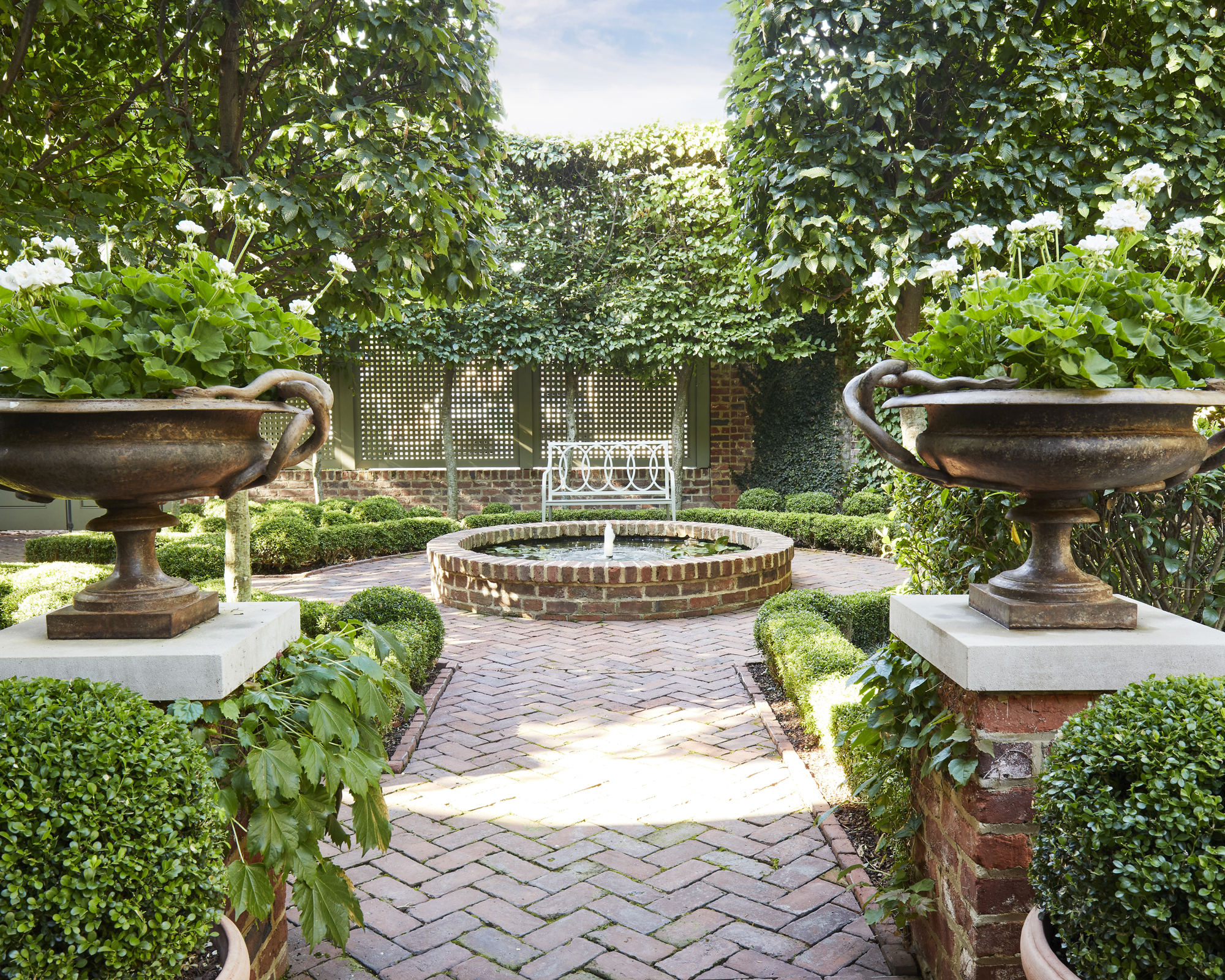
Adding water feature ideas to your garden design will allow you to boost to the sensory experience of your backyard, altering the mood and feeling, or bringing life and movement to even the smallest outdoor space.
A fountain or cascade can be energizing and create drama, while the still, reflective surface of a pond, or gentle flow of water in a rill or stream, can provide a meditative and soothing experience.
Water features offer the opportunity to add an interesting array of aquatic and marginal plants and increase the biodiversity for wildlife.
Water feature ideas can also act as a central focal point around which other backyard ideas, planting schemes and design features emanate.
Water feature ideas
‘Water feature ideas must work aesthetically and have purpose within the rest of your garden design. They don’t need to be complex, and sometimes the simplest designs will bring the most impact,’ explains John Wyer, CEO of garden design company Bowles & Wyer.
Before adding a water feature to your garden, consider what it is about one that appeals to you. There are many garden pond ideas that can create a therapeutic focal point.
'Is it the sound of moving water? A still body of water reflecting the sky and bouncing light around the garden? Perhaps a mysterious inky blue pool set into a shady corner? It all differs from person to person,' explains award-winning landscape and garden designer Helen Elks-Smith FSGD.
Design expertise in your inbox – from inspiring decorating ideas and beautiful celebrity homes to practical gardening advice and shopping round-ups.
Whether you want a quiet and calm watery element, the gentle tinkling sound of falling water, or a dramatic flow, will influence the design and style of the water feature. Before adding a water feature to your garden, consider what it is about one that appeals to you.
Below, we bring you our favorite water feature ideas – plus some vital advice.
1. Install a raised pond as a focal point

One of the main roles of water feature ideas within a backyard – whether a large space or a compact courtyard – is to create a focal point. Raised garden ponds like the one above are often placed centrally within a courtyard or at the end of a path to draw the eye.
Either way, it can be the starting point from which the rest of your garden design emanates. Adding pond plants will enhance the natural look and feel of the pond.
2. Create a restful feel with water rills

Rills are shallow channels along which water flows gently from one area to another. In Islamic gardens, rills were central features running along the main axis of the garden, often culminating in a fountain or pond.
'Rills can deliver a wonderful combination of sound and movement to a space, which in turn enhances the contemplative and restful atmosphere of the garden,' explains garden designer and landscaper Peter Reader.
'In this design for the Four Seasons show garden, the rill was constructed using honey colored Cotswold stone, which is a perfect foil for both the water and the plants. The naturalistic, aromatic planting style enhances the sensory, restful space.'
Rills can be constructed many different materials, and can work in both courtyard or larger gardens, one of many sensory garden ideas that can fill an outdoor space with sound and movement.
'Consider carefully where to site a rill to get the best from it. The principle of water, hardscape and planting is a winning combination, so trimming the design back to a single rill can be just as effective,' explains Peter.
3. Punctuate hard landscaping with garden pools
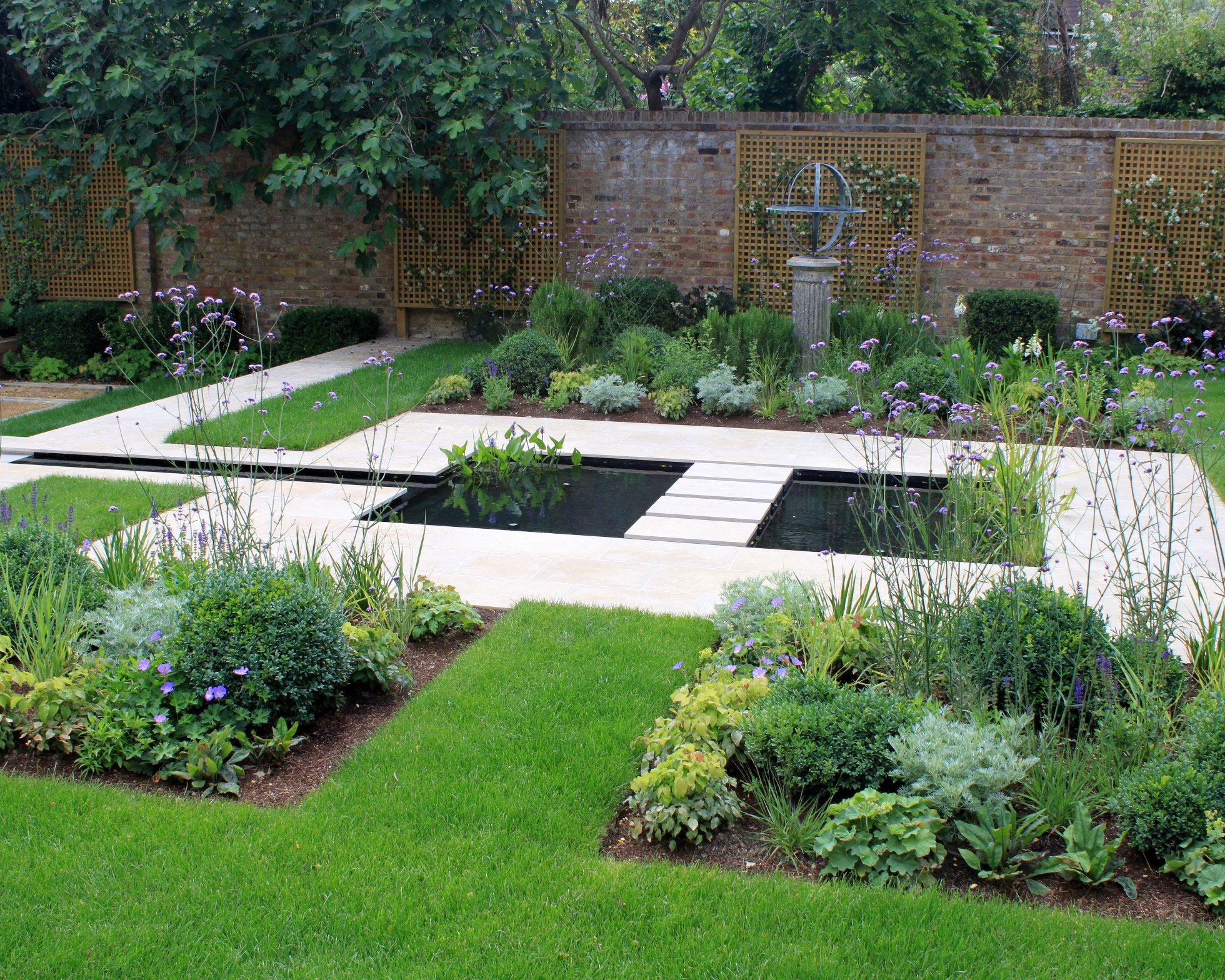
A pool can create a strong focal point in a garden and can be formal or more natural in design.
Formal pools often look better positioned close to a house. 'This semi-formal pool in a walled garden is a lovely visual focal point for the garden, enticing you out into the space from the house,' explains Peter Reader.
'Consider the position of the pool carefully, particularly in relation to how much sun it might receive, or where leaves might drop directly into it, as well as the views to and across it,' Peter adds.
Consider also whether it can be placed so that it delivers lovely reflections of surrounding planting or the sky on its surface.
'It is important to bear in mind the practicalities of keeping a pool healthy and attractive. Pools are living biomes where various factors must be managed to prevent problems such as blanket weed algae creating problems. Take advice from someone who understands the natural processes of water management,' says Peter.
4. Add sound and movement with a garden fountain
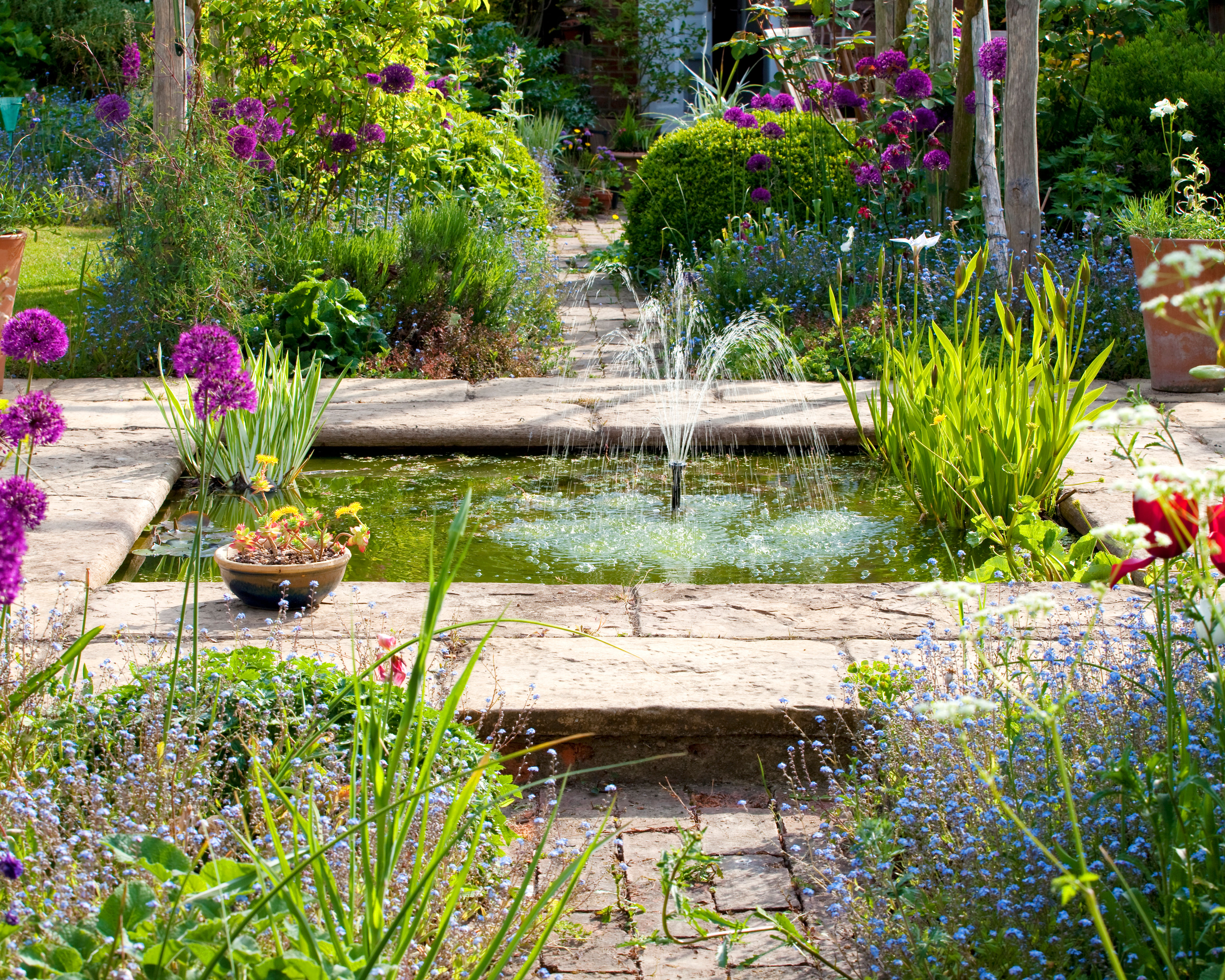
Garden fountains are dynamic water feature ideas that bring both sound and the visual impact of moving water to a garden.
They come in a wide range of possibilities, from a gentle trickle of water to a more dramatic, gushing flow.
'The sound of water contributes greatly to the atmosphere it creates,' explains Helen Elks-Smith.
The calculations for pumps and filtration on larger or more detailed garden fountains may require the involvement of a water engineer.
'You will need a power supply if you have a pump and are creating a flow of water. Pumps can be noisy and filtration units can be large depending on the size of the water feature, so location needs to be considered carefully,' explains Rosemary Coldstream.
Fountains work well in ponds, but as a general guide the pond should be at least twice as wide as the height of the water jet to avoid water waste or surrounding surfaces getting wet.
Alternatively, self-contained fountains require little or no excavation work and more often than not do not need to be installed by a specialist. 'Self-contained fountains need to be sited on a level footing, such as a patio, avoiding grass or undulating ground and work well in courtyard gardens, ' explains Nicola Clements of Haddonstone.
'It's best to try to avoid positioning your fountain under trees or tall shrubs as fallen leaves, branches and garden debris can cause algae build-up, harm to fish or clog the pump,' Nicola adds.
5. Introduce water to a small space with a water bowl
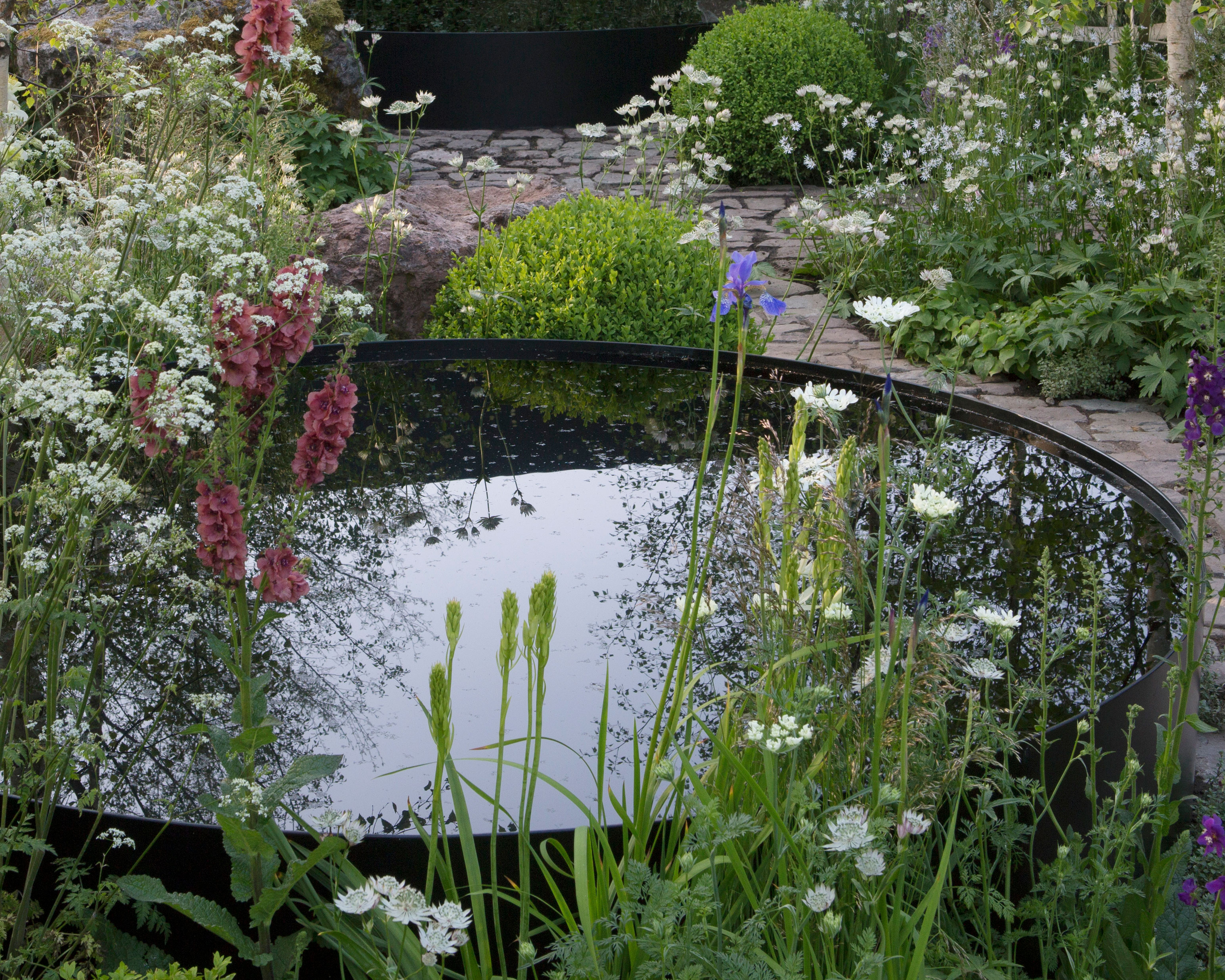
One of the simplest ways to introduce water to your outdoor living room ideas is with a water bowl or dish. Any shallow container will work, but choose one that can be cleaned easily as they can become green with algae.
'Small bodies of water heat up quickly, so if you don’t want to spend time constantly cleaning the water, it is essential to consider where it is positioned in terms of sunlight,' says Helen Elks-Smith.
Add aquatic plants to help to keep the water naturally clean and also encourage wildlife.
Stone bowls, metal dishes, weathered steel dishes, recycled containers and all manner of objects can be turned into water features. Select one that is in keeping with the style of your house and garden.
Where possible, when topping up the water, try to use collected rainwater or tap water that has stood for a few days to allow some of the chemicals to evaporate.
'If you’re using a still water feature, consider positioning it near trees so that you can see fantastic reflections on a calm day,' says John Wyer.
6. Add interest with a water feature sculpture
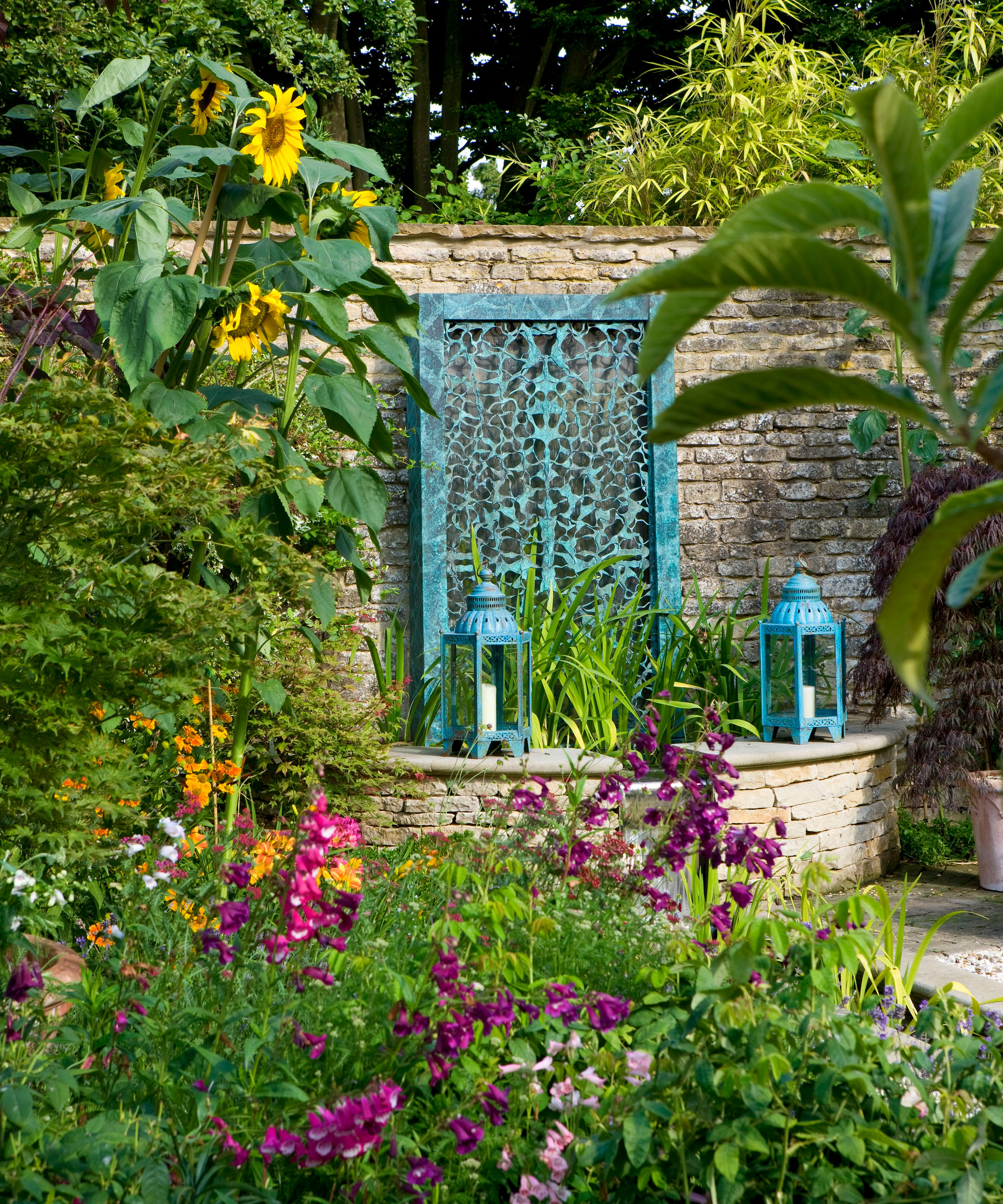
More stylized water feature ideas include sculptures or artwork.
These can often be used to lead the eye to a focal point or view, and can be constructed from a variety of materials, including steel, stone or even recycled materials to create distinctive, sculptural creations.
In this Filigree Water Wall by David Harber, water flows behind an irregular latticework of verdigris bronze.
'A water feature sculpture should react to and engage with the space it is commissioned for,' he explains.
Consider where the water sculpture will be positioned so that it can be enjoyed from many angles. 'Incorporating a water feature sculpture is often a softer choice than using other forms of garden sculpture, and also one that adds to the sensory experience of a garden,' says John Wyer.
7. Benefit your garden's ecology with a wildlife pond

Wildlife ponds can work in gardens of different sizes and styles and are excellent wildlife garden ideas to attract an array of creatures, from insects and birds, to amphibians and mammals.
Generally a more organic shape than a formal pool, wildlife ponds tend to be better positioned in quieter corners of the garden where the wild visitors will not be disturbed.
'Larger ponds should be positioned in a naturally low point in the garden to look right. Include aquatic plants in the water and marginals around the edge,' explains Rosemary Coldstream.
Include oxygenating plants, floating aquatic plants in aerated baskets and boggy marginal options to soften the edges. Select those that suit the climatic and soil conditions.
The ideal location is in part sun and part light shade. 'If the wildlife pond is located too near to trees, they can throw much of it into shade, dead leaves will need clearing and rotting leaves can release gases harmful to fish,' explains gardening writer and photographer Leigh Clapp.
Dig the pond to different water depths to attract a variety of wildlife, including at least one slope for allowing easy access and exit.
8. Introduce a water table to dining areas
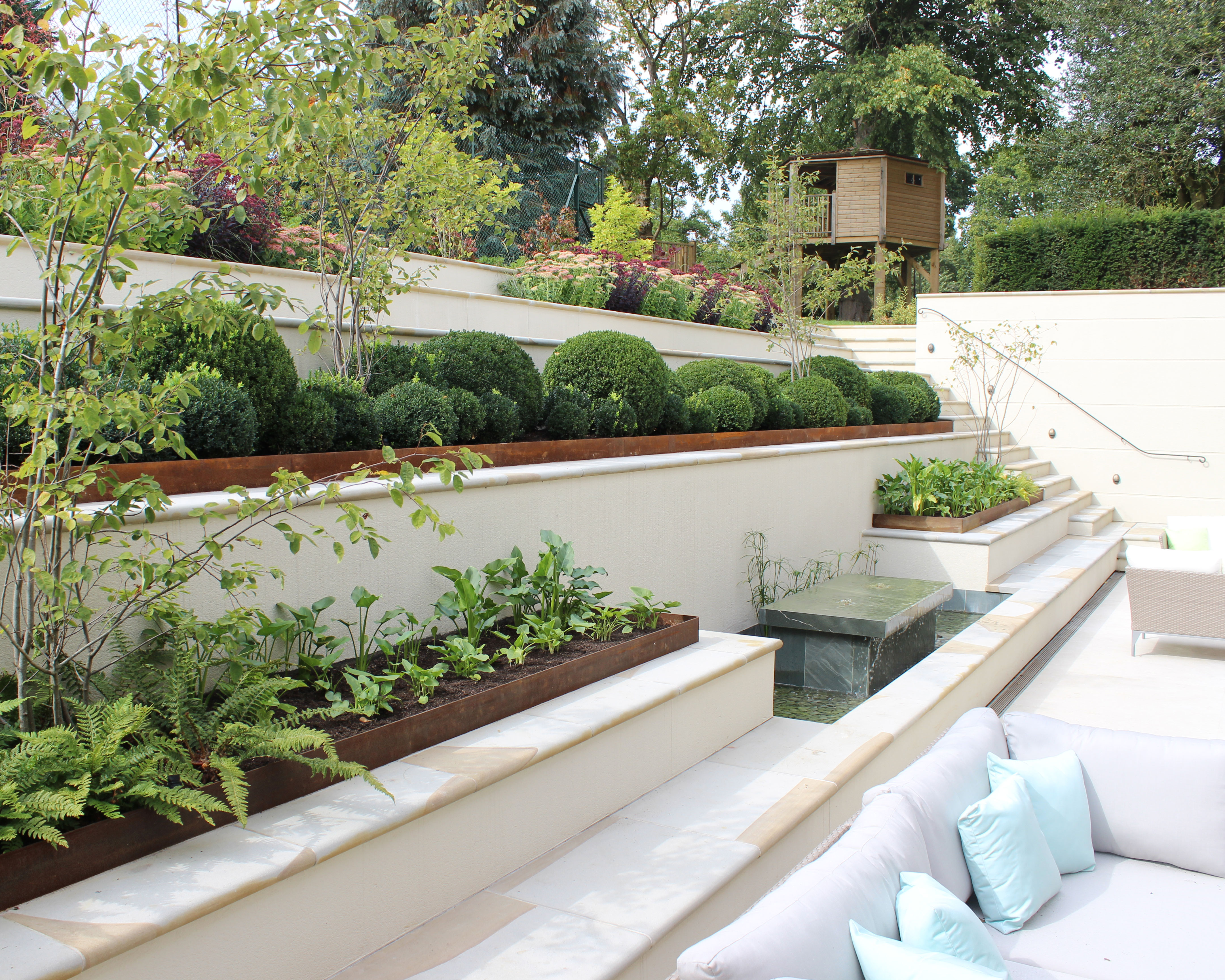
Water table garden features, with the meditative, gentle trickling of water over the sides, can add to the ambiance of your outdoor dining ideas.
'Consider nestling this water feature idea within a seating area and use it as a central focal point which captures attention,' advises John Wyer.
This simple, semi-elevated water table is made from Cumbrian slate, and the water spills over the sides in curtains.
'This courtyard has an almost Middle Eastern atmosphere, so the modest water feature and sound of trickling water seemed like the perfect placement here,' adds John.
Water tables can come in a variety of shapes and materials. Many will suit a more contemporary garden setting, although a stone design can be incorporated in a traditional garden design.
9. Create drama with a waterfall
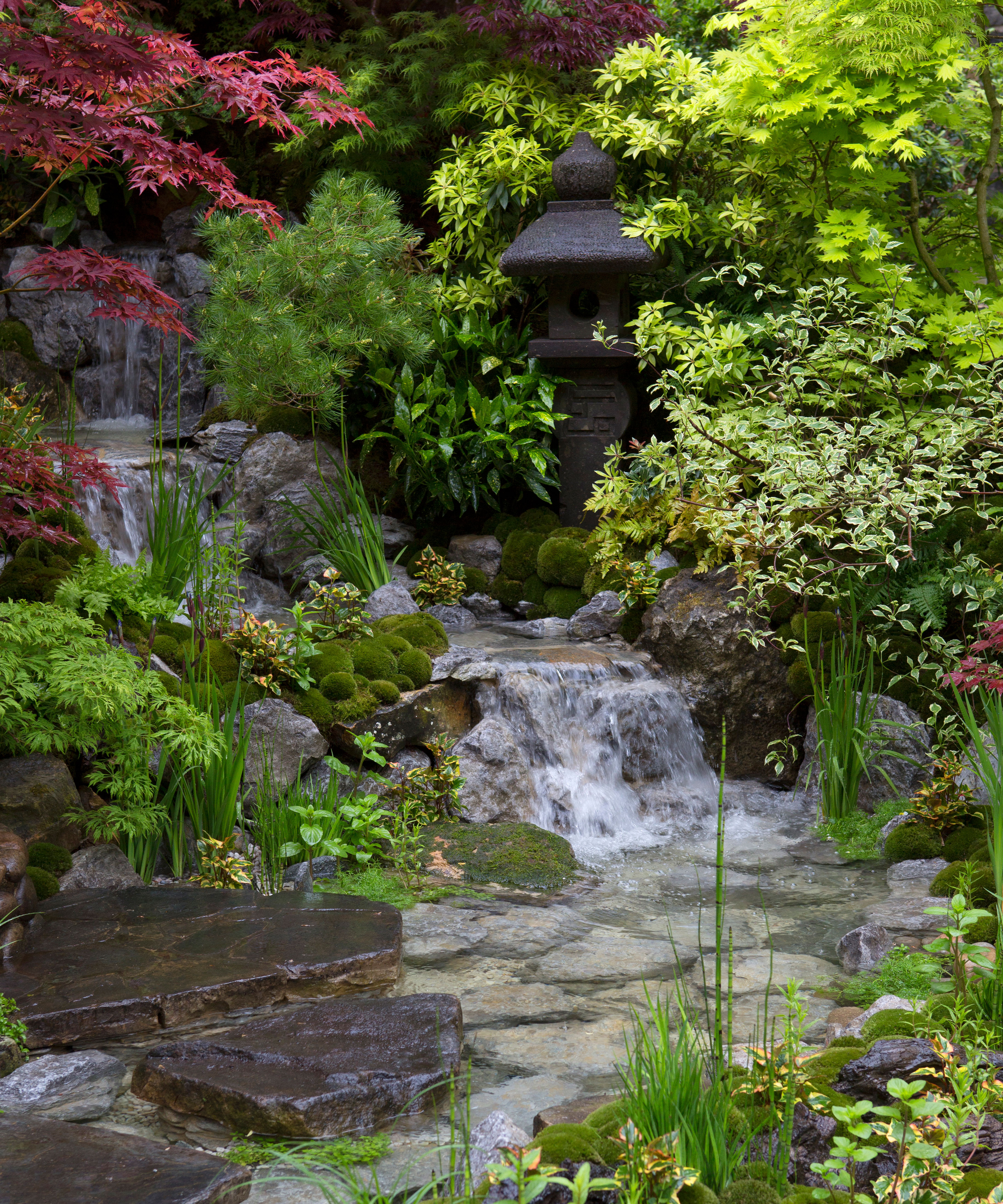
Waterfalls are a wonderful way to a sensory delight to the garden, and can be simple or complex water feature ideas as you wish.
The location, size and maintenance of a waterfall feature should be considered at the outset. Pumps will be needed to circulate the water, so this will require access to a power source.
'It is best to work with both a designer and a water specialist or good landscaper depending on the scale of the water feature,' advises Rosemary Coldstream.
As well as the cascading structure for the waterfall itself, you need to remember the pool into which the water flows.
10. Maximize a sloping site with a stream
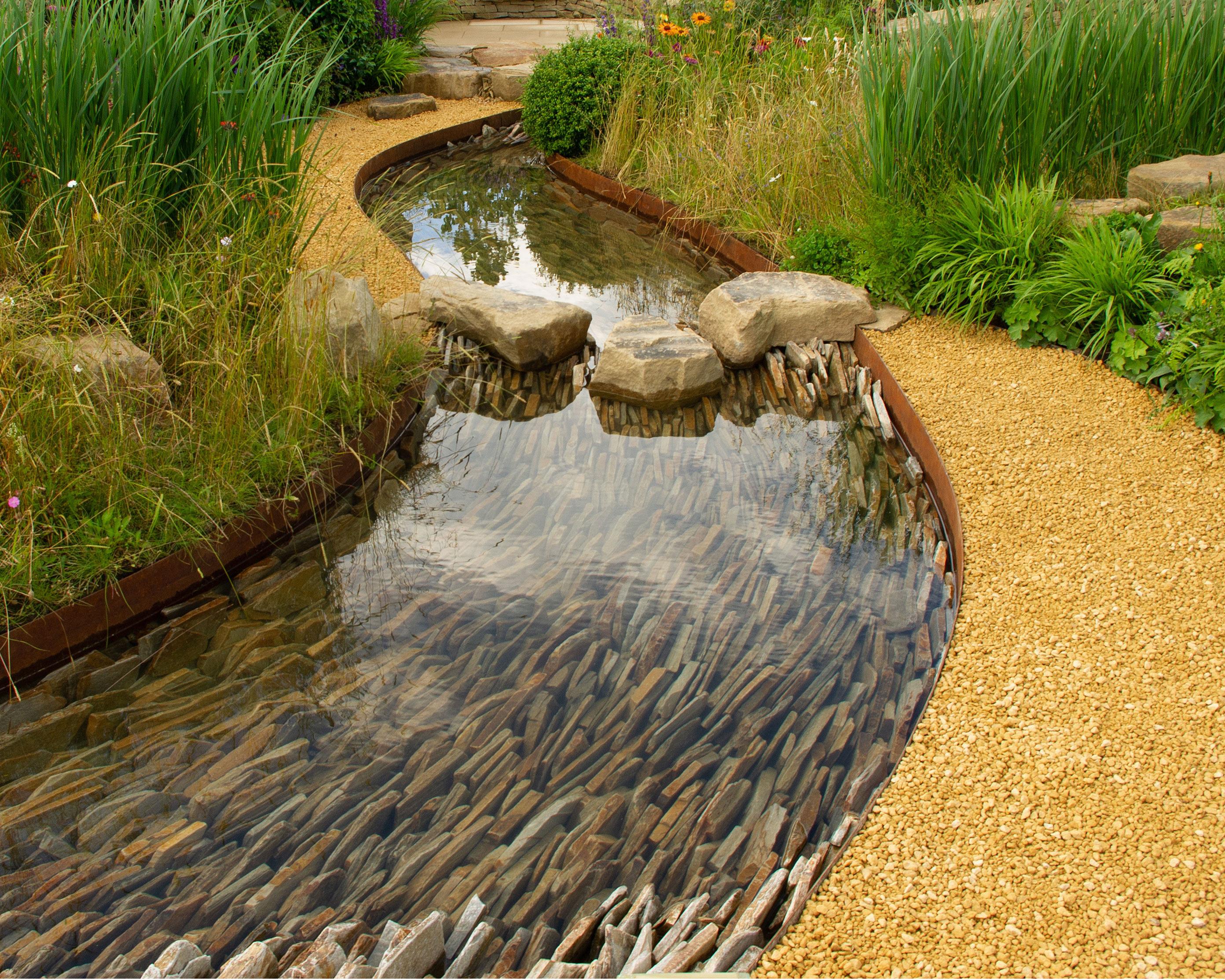
Some gardeners may be lucky enough to have a natural stream in their backyard, which they can draw attention to with beautiful marginal planting and placement of seating areas to enjoy the soothing effects of the running water.
You needn't be on a hill to take advantage of this most exciting of sloping garden ideas – even shallow banks can be used to create a manmade stream with a natural flow of water.
'There needs to be a slope for the water to go down, and the top and bottom of the stream need basins for the water to collect, ' explain the experts at Premier Ponds & Lighting.
Lining the base of the stream with slate or stone, such as in this design by Helen Elks-Smith, creates an attractive bed glimpsed through the water, 'and can also become home to beneficial bacteria that help clean the water and fight algae,' add the experts at Premier Ponds.
11. Install a birdbath to attract wildlife
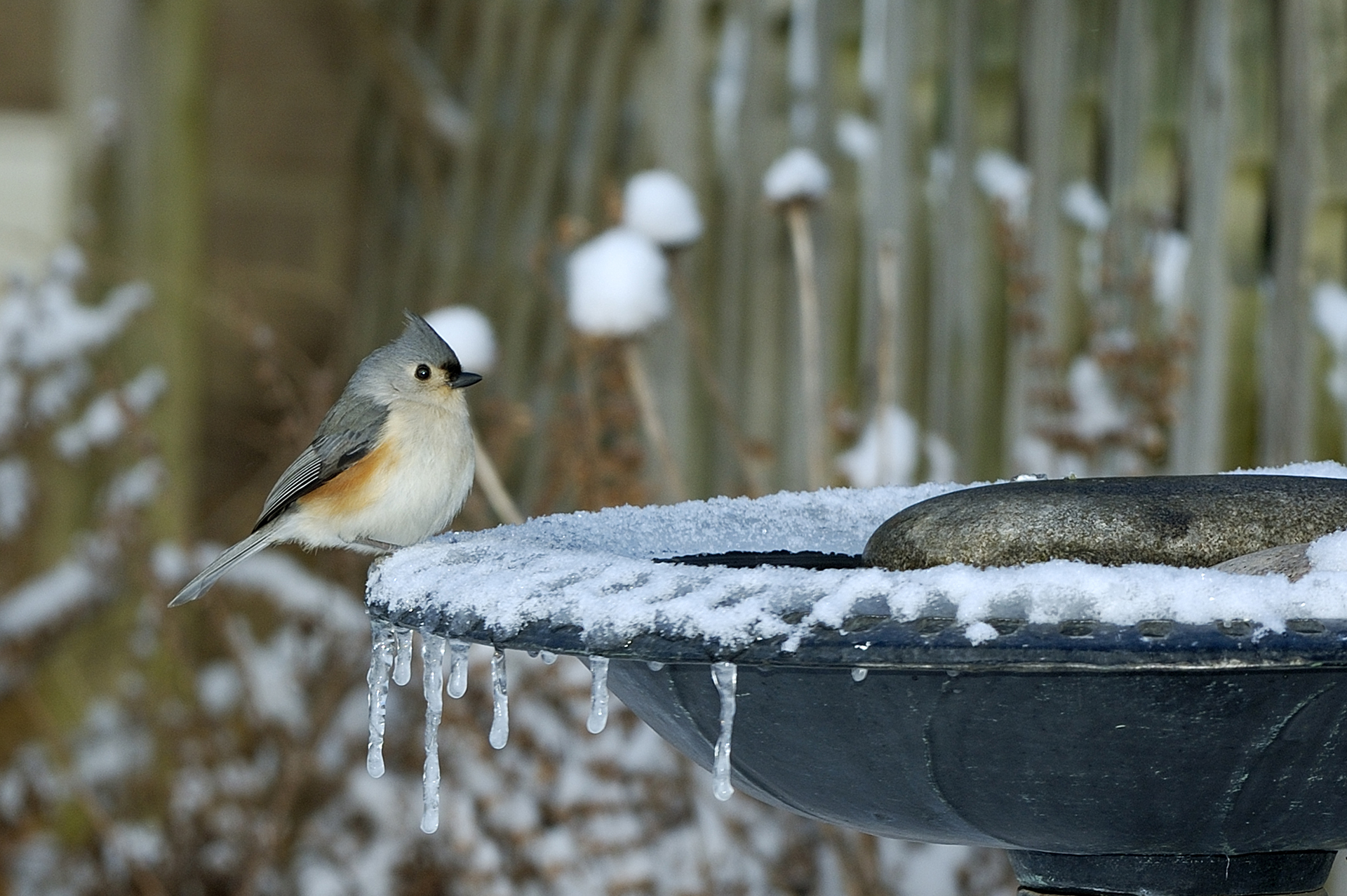
A feature birdbath will encourage wildlife into the garden. Songbirds need to bathe and drink, and it is a joy to watch them alighting on the rim of a birdbath, dipping their beaks in the water, or plunging in for a splash.
This is the perfect solution for a courtyard garden, or can be used to create a focal point among garden beds. As there is no requirement to instal pumps or filters, it is also the least disruptive to an existing garden design.
When adding a birdbath to your garden, consider that birds don't bathe in deep water, 'so keep the level of water in your birdbath to about two inches or less,' advises the experts on the Bird Watcher's Digest.
If the surface inside is too smooth, add in some pebbles to give them something to grip on.
Place it where it can be seen from the house so that you can enjoy the spectacle of birds enjoying this water feature year round.
How do you make an easy water feature?
To make an easy garden water feature, include a water bowl, water dish, or a birdbath.
You could also try a rock bowl, which is perfect for a paved courtyard or patio setting. Simply fill an attractive bowl or pot with rocks and pebbles, or use a collection of low bowls or shallow dishes for added impact,' advises gardening writer Leigh Clapp.
Many decorative containers, such as troughs, wooden barrels, or recycled metal buckets, can also be turned into small water feature ideas, suitable for aquatic plants.
No water feature is maintenance free, but careful planning can make it easier. There are a number of practical matters to consider, such as:
- The size of your outside space – large pools and ponds are perfect for wide open spaces, while smaller, self-contained fountains work perfectly on small patios and in courtyards;
- Consider the cost your chosen design, necessary installation and any ongoing energy costs;
- How the feature will be powered;
- Where the water will be pumped from or drain away to;
- The best position for the water feature, including how the natural light will interact with the water;
- Whether it can be enjoyed from a nearby seating area;
- ‘Will the water be cleaned naturally, using plants, or using a filtration system, which can be large and noisy depending on the size of the water feature,' says garden designer Rosemary Coldstream
- 'Will the water level fluctuate with the natural rainfall or be permanently at a certain level, which will require a water feed to top up and an overflow,’ Rosemary adds.
- Safety is always an important consideration if there are going to be children in the garden.
Can I install a water feature myself?
Depending on the style of water feature that you choose for your garden, it can require expert installation.
'While water features ideas may appear simple on the surface, there is often a lot more going on underground – they involve many technical and mechanical elements, from laying the pipes, to establishing the right water pressure,' explains John Wyer.
'Getting the water flow, filtration and waterproofing right are expert skills. It is best to work with both a designer and a water specialist or good landscaper depending on the scale of the water feature,' adds Rosemary Coldstream.
What plants look good around a water feature?
There are many options for aquatic and marginal plants that will elevate a water feature and help it to blend in with the garden setting.
For plants that float on the water, there are many varieties of water lilies, including dwarf and large forms, that flower from spring to summer.
For marginal plants, gunnera are large architectural plants that thrive in moist, boggy soil, while ostrich ferns grow in shady, damp areas.
If you're seeking colorful blooms, there are species of iris that grow in shallow water and pond margins, and daylilies are ideal for bog gardens, flowering from June to September.
Rachel is senior content editor, and writes gardening content for homesandgardens.com, Homes & Gardens magazine, and its sister titles Period Living Magazine and Country Homes & Interiors. She has written for lifestyle magazines for many years, with a particular focus on gardening, historic houses and arts and crafts, but started out her journalism career in BBC radio, where she enjoyed reporting on and writing programme scripts for all manner of stories. Rachel then moved into regional lifestyle magazines, where the topics she wrote about, and people she interviewed, were as varied and eclectic as they were on radio. Always harboring a passion for homes and gardens, she jumped at the opportunity to work on The English Home and The English Garden magazines for a number of years, before joining the Period Living team.
